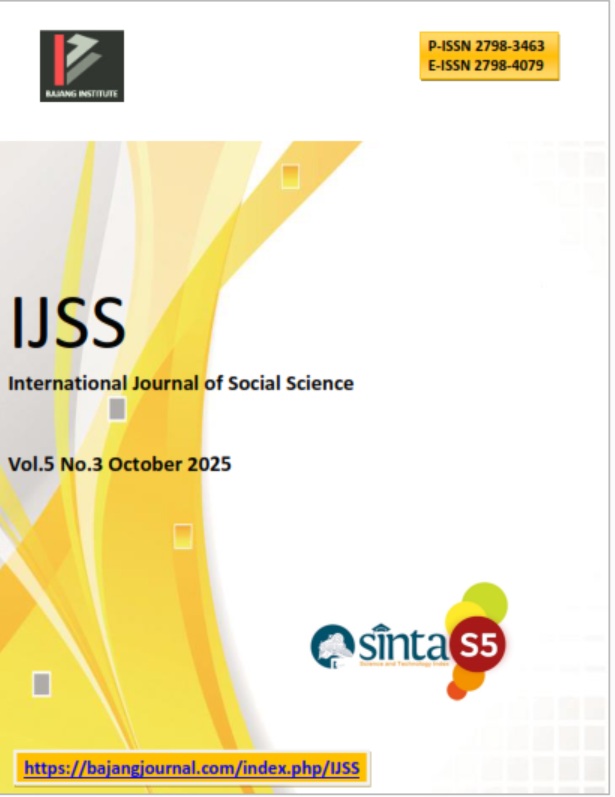PUSPA RAKSAKA JAGAD; DESIGN OF ECO-FRIENDLY FASHION INNOVATIONS IN CHILDREN’S KEBAYA
DOI:
https://doi.org/10.53625/ijss.v5i3.11304Keywords:
Puspa Raksaka Jagad, Eco-Friendly, Children’s Kebaya, Upcycle Thrift, Eco PrintAbstract
This research explores the concept of Puspa Raksaka Jagad, which involves creating children's kebaya based on eco-friendly principles by integrating upcycling techniques from thrifted clothing and ecoprinting using natural dyes derived from ylang-ylang, frangipani, and hibiscus flowers. The aim of this research is to produce children's kebaya that are not only aesthetically pleasing and comfortable to wear, but also environmentally friendly and sustainable. The methods employed include exploring recycled materials in the form of thrifted clothing, designing kebayas with unique ecoprint motifs, and creating products through the ecoprint pounding technique, which utilizes natural pigments from local plants. The results of the study show that the use of upcycling and ecoprint pounding techniques can produce children's kebaya with high aesthetic value, while reducing textile waste and the use of synthetic chemicals. This product also makes a positive contribution to cultural and environmental preservation. Puspa Raksaka Jagad is a children's fashion innovation that prioritizes sustainability, creativity, and local wisdom.References
D. A. P. L. Sari, “Thrift Fashion dalam Perubahan Paradigma Pandemi; Dilarang tapi Digemari?,” in Dasa Citta Desain 2022: Desainer Sebagai Pencipta Nilai, Denpasar: Institut Seni Indonesia Denpasar, 2022, pp. 130–145.
K. Z. Tandjung, A. Arumsari, and G. S. Takao, “UPCYCLE LIMBAH PAKAIAN BEKAS IMPOR MENJADI MODESTWEAR MENGGUNAKAN TEKNIK PATCHWORK DAN EMBELLISHMENT,” presented at the e-Proceeding of Art & Design :, Pebruari 2024.
M. S. Herlina, F. A. Dartono, and Setyawan, “Eksplorasi Eco Printing untuk Produk Sustainable Fashion,” Ornamen; Jurnal Kriya, vol. 15, no. 2, pp. 118–130, 2018.
S. Nurjanah and I. A. I. Candra, “Ecoprint Pounding: Inovasi Ramah Lingkungan dalam Pelatihan Batik di IAIN Ambon,” Jurnal Abdidas, vol. 5, no. 4, pp. 331–337, July 2024, doi: 10.31004/abdidas.v5i4.957.
A. R. Hikmah and D. Retnasari, “ECOPRINT SEBAGAI ALTERNATIF PELUANG USAHA FASHION YANG RAMAH LINGKUNGAN,” Prosiding Pendidikan Teknik Boga Busana, vol. 16, no. 1, Oct. 2021, Accessed: Sept. 09, 2025. [Online]. Available: https://jurnal.uny.ac.id/index.php/ptbb/article/view/44478
A. Afrahamiryano, H. Roza, R. K. Dewi, D. D. E. Wati, I. Hanafi, and C. Amri, “EDUKASI DAN PEMANFAATAN BAHAN ALAM UNTUK PEMBUATAN ECOPRINT,” CDJ, vol. 3, no. 2, pp. 1209–1213, July 2022, doi: 10.31004/cdj.v3i2.5714.
H. Hendriyana, Metodologi Penelitian Penciptaan Karya, 2nd ed. Yogyakarta: Andi, 2021.
S. ; Gustami, Butir-butir mutiara estetika timur : Ide dasar penciptaan seni kriya Indonesia. Prasista, 2007. Accessed: Sept. 07, 2025. [Online]. Available: //opac.isi.ac.id%2Findex.php%3Fp%3Dshow_detail%26id%3D16876
Downloads
Published
How to Cite
Issue
Section
License
Copyright (c) 2025 Dewa Ayu Putu Leliana Sari

This work is licensed under a Creative Commons Attribution 4.0 International License.

















